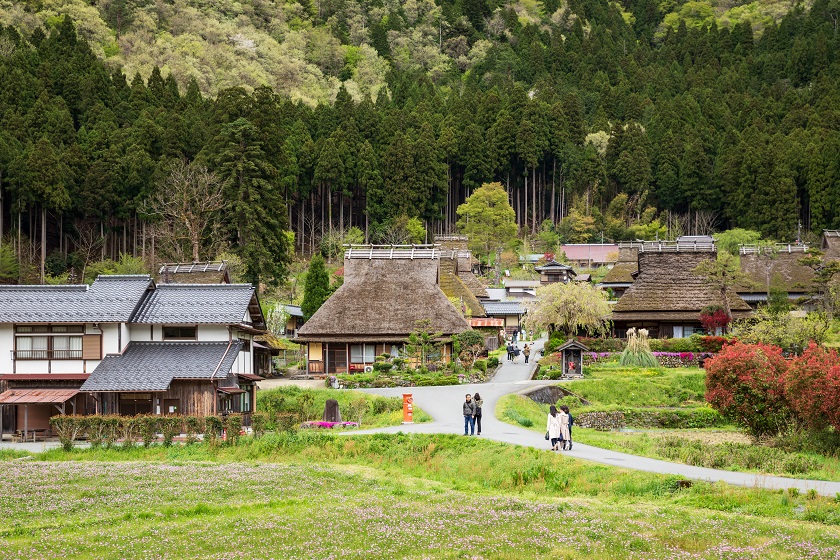To experience traditional rural life while visiting Kyoto, make a side trip to the serene villages of Miyama in the mountains.
Kyoto is a destination famous for its traditional side and many historical landmarks. But even a place like Kyoto has limitations on what it can show visitors. While it’s great for experiencing historic city life, learning about Japan’s rural traditions is another story entirely. Enter the serene rural villages of Miyama, the perfect place for international tourists to see the region’s traditional nature and witness satoyama culture up close.
Here is everything you need to know about making a trip to Miyama from Kyoto to experience the town’s fantastic traditional village atmosphere with its thatched roofs and old-fashioned rural life.
Background to Miyama and its Villages
The town of Miyama is located roughly 50 kilometres north of Kyoto among the mountains of Kyoto Prefecture. As Miyama literally translates as ‘beautiful mountains’, it’s no secret what kind of landscape it offers those who visit.
But what makes Miyama so special is the way that its traditional rural culture of community and sustainability has survived. Throughout the town of Miyama and its 26 surrounding villages there are over 200 thatched roof farmhouses or kayabuki and roughly 4200-5000 residents.
The region’s sense of history and adherence to old-fashioned farming values makes it one of the best places in Japan to visit to experience satoyama. This Japanese concept values a deep respect for nature and what it can provide. So, while Miyama feels rustic and from another time, it’s also self-sufficient and ecologically sustainable.
Things to Do in Miyama

One of the best things about travelling to Miyama is the surprising range of things to do there. No matter your interests, you should be able to find a few different activities to keep you entertained.
Kayabuki no Sato
The most popular attraction in Miyama is the fabulously preserved village of Kayabuki no Sato. Within this northern village visitors will find almost 40 thatched-roof farm houses dotted among simple countryside. Kayabuki no Sato feels made for strolling as meandering about lets you take in the thatched village’s humble charms and imagine a simpler time. Oh and this is no open-air museum, all of the houses are private homes where people still live and work to this day.
Museums in Kayabuki no Sato
To actually see what one of these thatched roof houses looks like from the inside, you’ll need to visit the Miyama Folk Museum in Kayabuki no Sato. The building dates from the 19th century and provides a faithful look at life in these parts. Another local museum worth checking out is the Little Indigo Museum, which is an indigo dyeing studio and gallery set inside another old house. There you can learn about traditional Japanese dyeing techniques and properties of the Japanese indigo plant.
Miyama Kayabuki Gallery and Folk Museum
Despite the similarity in its name, the Miyama Kayabuki Gallery and Folk Museum is actually a separate attraction from the museums mentioned earlier. Found in the town centre of Miyama close to the Miyama Post Office, this attraction has a museum section and a gallery section. The museum features a collection of traditional tools and artifacts from the area, while the gallery is an exhibition space for a revolving roster of local artists.
Hiking in Miyama
Thanks to its location up among the mountains with plenty of nature around, Miyama is a great destination for hiking. Visitors have a generous selection of walks and hikes to choose from, with the riverside walk from Kayabuki no Sato to the Shizen Bunkamura Kajikaso a good gentle starting point.
More challenging hikes include going in search of local waterfalls or taking off into the Ashiu Forest for the source of the Yura River. The important thing to know is that entering the Ashiu Forest requires a permit and therefore is best done with a guided tour.
Traditional Japanese Activities

Because of how important tradition is in Miyama, the town and surrounding villages are a great place to experience all sorts of traditional Japanese activities. These experiences include trying on customary clothes like kimonos and yukata, participating in a Japanese green tea ceremony, and learning to make your own bento meal or other cooking classes.
Information for Visiting Miyama
- Miyama gets busy during cherry blossom season, so May and June are often considered the best time to visit. The region hosts various festivals throughout the year, so it’s best to check the region’s event calendar to see if you can time your visit for one.
- Most itineraries for Miyama recommend staying two days in the area to fully soak up its scenery and character.
- For those choosing to stay in Miyama, there is a fantastic range of accommodation available among its villages, including ryokan and even cottages.
- There are several options for getting about Miyama. Many say that renting a bicycle is best if you get there with public transport, as local buses aren’t very frequent.
Travelling to Miyama with the JR Pass
International travellers who want to visit Miyama will find public transport a great way to get there. Unfortunately though, the JR Pass is only able to cover part of the journey from nearby Kyoto.
To get to Miyama, take the JR Sagano Line to Hiyoshi Station on the edge of Nantan. From there, you’ll need to buy a bus ticket or pass from Hiyoshi to the Kita bus stop in Miyama, just outside Kayabuki no Sato. The trip should take, including transfers, between 2 and 3 hours.

.png)


